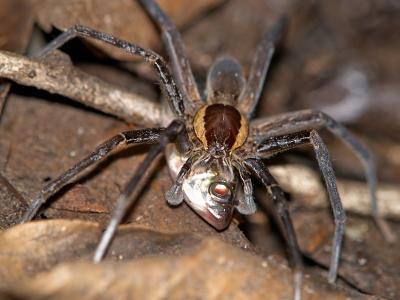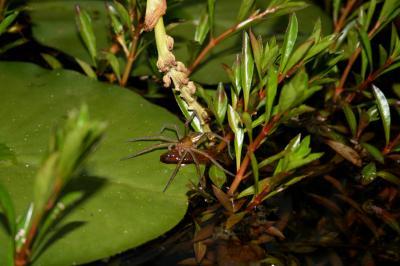Spiders are traditionally viewed as predators of insects but zoologists have published a study that finds spiders all over the world also prey on fish.
That spiders are not exclusively insectivorous and larger-sized species supplement their diet by occasionally catching small fish is somewhat new.
According to their systematic review, spiders from as many as five families have been observed predating on small fish in the wild and three more families contain species that catch fish under laboratory conditions. These so called semi-aquatic spiders typically dwell at the fringes of shallow freshwater streams, ponds or swamps. These spiders, some of which are capable of swimming, diving and walking on the water surface, have powerful neurotoxins and enzymes that enable them to kill and digest fish that often exceed them in size and weight.

This is an adult male of Ancylometes sp. (possibly Ancylometes rufus) caught characiform (Cyphocharax sp.) near Samona Lodge, Cuyabeno Wildlife Reserve, Ecuador.
Credit: Ed Germain, Sydney, Australia
Fish as a diet supplement
“The finding of such a large diversity of spiders engaging in fish predation is novel. Our evidence suggests that fish might be an occasional prey item of substantial nutritional importance,” says Martin Nyffeler from the University of Basel, Switzerland.
Based on this study, naturally occurring fish predation by spiders has been reported from all continents with the exception of Antarctica. Most incidents have been documented in North America, especially in the wetlands of Florida, where semi-aquatic spiders have often been witnessed catching and eating small freshwater fish such as mosquitofish.

Dolomedes facetus captured pond fish (genus Xiphophorus) in a garden pond near Brisbane, Queensland, Australia. Credit: by Peter Liley, Moffat Beach, Queensland
The fish will then be dragged to a dry place before the feeding process can begin which usually lasts several hours.


